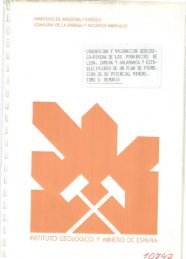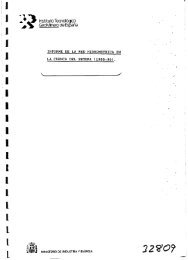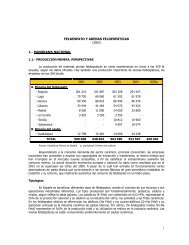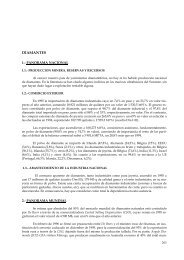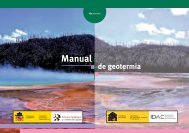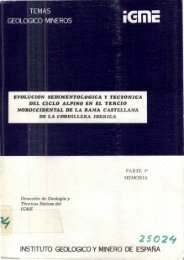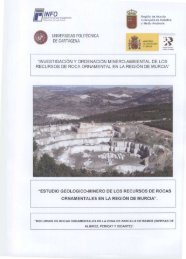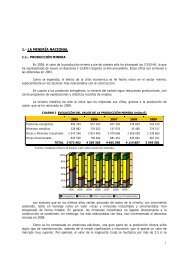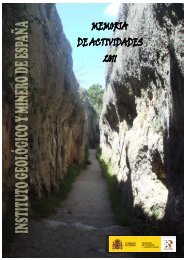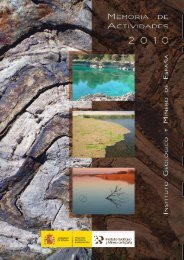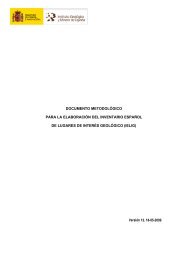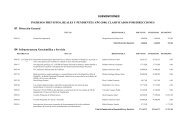mesozoic successions of the betic and iberian ranges - Instituto ...
mesozoic successions of the betic and iberian ranges - Instituto ...
mesozoic successions of the betic and iberian ranges - Instituto ...
You also want an ePaper? Increase the reach of your titles
YUMPU automatically turns print PDFs into web optimized ePapers that Google loves.
The Betic <strong>and</strong> Iberian Mountain Ranges display outcrops<br />
<strong>of</strong> Mesozoic rocks <strong>of</strong> great quality <strong>and</strong> continuity,<br />
<strong>and</strong> with abundant fossil remains, which have allowed<br />
to describe detailed stratigraphic series, with facies<br />
interpretation, sequence stratigraphic analysis, dating<br />
<strong>of</strong> rocks, <strong>and</strong> <strong>the</strong> definition <strong>of</strong> litho-, bio- <strong>and</strong> chronostratigraphic<br />
units with regional <strong>and</strong> even global<br />
relevance. These rocks record <strong>the</strong> geological processes<br />
<strong>and</strong> biological evolution which took place for 185 million<br />
years, <strong>the</strong> duration <strong>of</strong> <strong>the</strong> Mesozoic Era.<br />
Some <strong>of</strong> <strong>the</strong> existing facies <strong>and</strong> <strong>of</strong> <strong>the</strong> depositional<br />
models described to interpret <strong>the</strong>ir origin are spectacular<br />
examples, in some cases unique in <strong>the</strong> world.<br />
The biozonations proposed based on <strong>the</strong> study <strong>of</strong><br />
Mesozoic fossil groups from <strong>the</strong> Betic <strong>and</strong> Iberian<br />
Mountain Ranges (ammonites, benthic foraminifera,<br />
planktonic foraminifera, nanoplankton, etc.) are useful<br />
references throughout <strong>the</strong> Tethys region <strong>and</strong>, quite<br />
frequently, <strong>the</strong>y are significant examples <strong>of</strong> global<br />
scale correlation between fossil groups.<br />
In <strong>the</strong> sou<strong>the</strong>astern margin <strong>of</strong> <strong>the</strong> Iberian Massif,<br />
<strong>the</strong> westernmost exposure <strong>of</strong> <strong>the</strong> European Variscan<br />
Orogen, <strong>the</strong>re are two big units corresponding to<br />
<strong>the</strong> Alpine Ranges (Figure 1): <strong>the</strong> Betic Mountain<br />
Range, in <strong>the</strong> sou<strong>the</strong>rn Iberian Plate, <strong>and</strong> <strong>the</strong> Iberian<br />
Mountain Range east <strong>of</strong> <strong>the</strong> Iberian Massif.<br />
THE BETIC MOUNTAIN RANGE<br />
As a geological <strong>and</strong> topographic unit, <strong>the</strong> Betic<br />
Mountain Range comprises <strong>the</strong> mountain reliefs south<br />
<strong>of</strong> <strong>the</strong> Guadalquivir river, <strong>and</strong> <strong>the</strong>ir nor<strong>the</strong>ast extention<br />
into Albacete, Murcia <strong>and</strong> south <strong>of</strong> Valencia. It<br />
is located between <strong>the</strong> Iberian Massif <strong>and</strong> <strong>the</strong> Iberian<br />
Mountain range to <strong>the</strong> north, <strong>and</strong> <strong>the</strong> Atlantic <strong>and</strong><br />
Mediterranean coastlines to <strong>the</strong> south, although<br />
it actually continues under <strong>the</strong> sea connecting with<br />
o<strong>the</strong>r Alpine domains: <strong>the</strong> north African rif, <strong>and</strong><br />
<strong>the</strong> Balearic Isl<strong>and</strong>s. Hence, all <strong>the</strong> substrate <strong>of</strong> <strong>the</strong><br />
Alborán Sea, most <strong>of</strong> <strong>the</strong> Cadiz Gulf substrate, <strong>and</strong><br />
part <strong>of</strong> <strong>the</strong> Mediterranean sea bottom between <strong>the</strong><br />
coasts <strong>of</strong> Valencia <strong>and</strong> Murcia, as well as <strong>the</strong> isl<strong>and</strong>s<br />
should be considered as submerged areas <strong>of</strong> <strong>the</strong> Betic<br />
Mountain Range (Figure 1).<br />
Two great divisions <strong>of</strong> tectono-stratigraphic character<br />
are differentiated in it: <strong>the</strong> Internal Zones <strong>and</strong><br />
<strong>the</strong> External Zones (Figure 2). The Internal Zones<br />
include <strong>the</strong> highest elevations <strong>and</strong> consist <strong>of</strong> crystalline<br />
basement <strong>and</strong> sedimentary cover with a complex<br />
structure <strong>of</strong> large decollement thrusts with different<br />
tectonic units <strong>of</strong> Paleozoic <strong>and</strong> Triassic rocks. Some<br />
units also include Mesozoic <strong>and</strong> Tertiary rocks. In all<br />
cases, <strong>the</strong>se are allochthonous units belonging to <strong>the</strong><br />
Alborán subplate.<br />
The External Zones are represented by a belt <strong>of</strong><br />
sedimentary rocks forming <strong>the</strong> nor<strong>the</strong>rn sector<br />
<strong>of</strong> <strong>the</strong> mountain range. Paleogeographically, <strong>the</strong><br />
External Zones correspond to <strong>the</strong> deposits accumulated<br />
in <strong>the</strong> continental margin <strong>of</strong> <strong>the</strong> Iberian Plate<br />
Figure 1. Geological map <strong>of</strong> <strong>the</strong> western<br />
Perimediterranean Alpine Orogen (Vera, 2004).<br />
(sou<strong>the</strong>rn Iberian paleo-margin) during <strong>the</strong> Mesozoic<br />
<strong>and</strong> Tertiary. The Guadalquivir basin is found to <strong>the</strong><br />
north, filled with Neogene deposits. The Campo de<br />
Gibraltar Complex is formed by allochthonous units<br />
with Cretaceous <strong>and</strong> Tertiary mostly turbiditic deposits<br />
along <strong>the</strong> contact between <strong>the</strong> External <strong>and</strong> Internal<br />
Zones.<br />
The Mesozoic series <strong>of</strong> <strong>the</strong> Betic Mountain Range<br />
mostly crops out in <strong>the</strong> External Zones <strong>of</strong> <strong>the</strong><br />
Mountain Range, with some limited outcrops in <strong>the</strong><br />
Internal Zones <strong>and</strong> <strong>the</strong> Campo de Gibraltar Complex.<br />
Based on <strong>the</strong> Mesozoic stratigraphic record <strong>and</strong> <strong>the</strong><br />
tectonic position <strong>of</strong> <strong>the</strong> units, two great sub-divisions<br />
are usually differentiated: <strong>the</strong> Pre-Betic Zone <strong>and</strong> <strong>the</strong><br />
Sub-Betic Zone (Figure 2).<br />
The Mesozoic <strong>of</strong> <strong>the</strong> Pre-Betic Zone is essentially<br />
formed by shallow marine deposits which, to <strong>the</strong> north<br />
<strong>and</strong> northwest, transition to <strong>the</strong> forel<strong>and</strong>. From a tectonic<br />
point <strong>of</strong> view, <strong>the</strong> Pre-Betic Zone is considered<br />
<strong>the</strong> relative autochthonous to <strong>the</strong> Sub-Betic units. In<br />
<strong>the</strong> Sub-Betic Zone, <strong>the</strong> innermost tectonic units, i.e.<br />
those located inside <strong>the</strong> mountain range, are thrusted<br />
upon <strong>the</strong> most external units, <strong>and</strong> <strong>the</strong>se in turn are<br />
thrusted upon <strong>the</strong> Pre-Betic (Figure 3).<br />
The Intermediate Domain was a subsident basin<br />
adjacent to <strong>the</strong> Pre-Betic shelf since <strong>the</strong> end <strong>of</strong> <strong>the</strong><br />
Middle Jurassic, <strong>and</strong> where terrigenous <strong>and</strong> calcareous<br />
turbidites were deposited during <strong>the</strong> Late Jurassic<br />
<strong>and</strong> Early Cretaceous. The External <strong>and</strong> Internal Sub-<br />
Betic created shallower marine areas where pelagic<br />
sedimentation prevailed. The areas displaying <strong>the</strong>se<br />
features have been called pelagic thresholds (García-<br />
Hernández et al.,1988). On <strong>the</strong> contrary, <strong>the</strong> Middle<br />
Sub-Betic was a subsident area located between <strong>the</strong><br />
pelagic thresholds <strong>of</strong> <strong>the</strong> Internal <strong>and</strong> External Sub-<br />
Betic, limiting it to <strong>the</strong> north <strong>and</strong> south, where thick<br />
series <strong>of</strong> pelagic sediments were deposited.<br />
Although it has not been possible to accurately set <strong>the</strong><br />
end <strong>of</strong> <strong>the</strong> Variscan Paleozoic cycle <strong>and</strong> <strong>the</strong> beginning<br />
<strong>of</strong> <strong>the</strong> Alpine Mesozoic Cycle, in <strong>the</strong> Betic Mountain<br />
74<br />
Castro, J.M. - García, A. - Gómez, J.J. - Goy, A. - Molina, J.M. - Ruíz Ortíz, P.A. - Sopeña, A.



